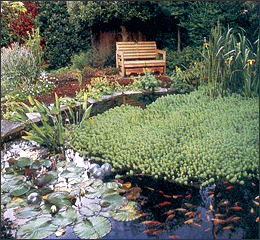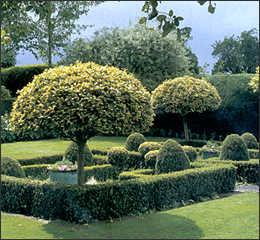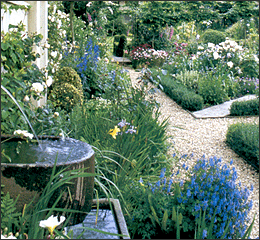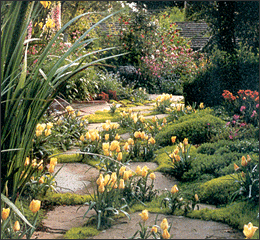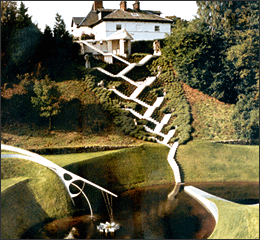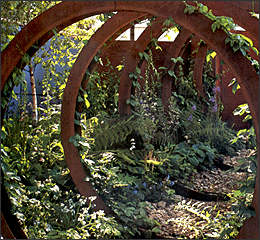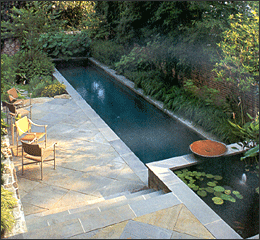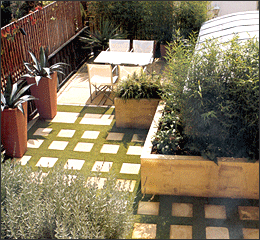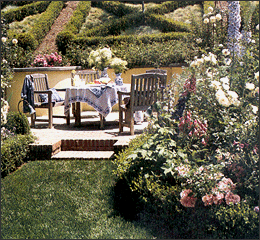Garden
1. A Garden in My Heart
 Garden! A word that seems to have almost disappeared in Korea. More unfamiliar than the word ‘landscape’, which is used more commonly, is the word ‘garden’. Nevertheless, we too have memories associated with the word ‘garden’. When we hear the word ‘garden’, we think of the yard. Memories of the camphor tree in the front yard of our childhood home, the peonies in the flowerbed, the pomegranate tree with its bright red fruits, the fig tree… and the lettuce wraps we ate on the picnic table in the front yard during summer. The sound of rainwater falling into the bucket and the well during a rainy day that made us feel drowsy even in the middle of the day, and the jar stand…
Garden! A word that seems to have almost disappeared in Korea. More unfamiliar than the word ‘landscape’, which is used more commonly, is the word ‘garden’. Nevertheless, we too have memories associated with the word ‘garden’. When we hear the word ‘garden’, we think of the yard. Memories of the camphor tree in the front yard of our childhood home, the peonies in the flowerbed, the pomegranate tree with its bright red fruits, the fig tree… and the lettuce wraps we ate on the picnic table in the front yard during summer. The sound of rainwater falling into the bucket and the well during a rainy day that made us feel drowsy even in the middle of the day, and the jar stand…
 But afterwards, we all moved to cities, one after another… We forgot about the yard and lived in cities without soil. We became familiar with the word ‘landscape’ instead of ‘garden’, and saw it occasionally in road signs near the city, or in places that sold trees, stones, and other materials needed to make city streets, parks, etc. We tried to feel a little bit of our garden in our hearts by briefly looking at already-made, nationality-less parks that we passed by, visiting places where traditional Korean houses were preserved or restored, and so on. We just tried to feel it.
But afterwards, we all moved to cities, one after another… We forgot about the yard and lived in cities without soil. We became familiar with the word ‘landscape’ instead of ‘garden’, and saw it occasionally in road signs near the city, or in places that sold trees, stones, and other materials needed to make city streets, parks, etc. We tried to feel a little bit of our garden in our hearts by briefly looking at already-made, nationality-less parks that we passed by, visiting places where traditional Korean houses were preserved or restored, and so on. We just tried to feel it.
Here in Toronto! In the fall, the entire city turns yellow and red. In the spring, it is covered in green, and it is not easy to spot the roofs of the houses below even from high buildings. The words ‘garden’ and ‘backyard’ are commonly seen and have become a part of people’s lives here.
We are so happy. We can open our front door and go for a walk to green parks, forests, and hear the sounds of birds. Some people who love gardens create their own backyard garden paradise while living in their homes.
Toronto makes me feel my own breath again. It makes me think of my garden in my heart once again. Although my main profession has changed a bit, if my expertise and knowledge related to gardens can help my customers make their homes happier, I will always be happy and grateful.
A garden in my heart – it is my hometown.
2. Garden - What and how?
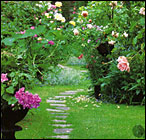 Garden – What do you need and how do you create it?
Garden – What do you need and how do you create it?
It could be explained simply, but to make it easy to understand, detailed descriptions are required for each item, which is too vast to cover on this page. Therefore, only conceptual matters will be mentioned here, and specific matters will be addressed separately.
As everyone knows, the basics of a garden are grass, trees, and flowers. However, these elements may not occupy a large proportion in some gardens. They are only a small part of the many elements that make up a garden. There are also many beautiful gardens without any living trees or grass.
We look at the typical colors that match the atmosphere we want to create.
- Trees, flowers - for the changes in the four seasons (spring vitality, summer greenery, autumn foliage, winter snowflakes), for the changes in flower and color.
- Water - the most dynamic ingredient that can give vivid natural sound and life to the garden (ponds, waterfalls, fountains, cascades, mist...).
- Stone, gravel - the most natural materials that go well with the natural atmosphere (large rocks, pebbles, paving stones, river gravel, colored gravel, crushed stones, sand...).
- Wood - materials for garden facilities such as decks, chairs, trellises, pergolas, etc.
- Brick, block - the most common flooring and wall materials.
- Garden ornaments - countless decorative items such as garden lanterns, sculptures, ornamental stones, fountains, and planters.
- Easily accessible decorative (?) materials - used tires, broken stones, rusted iron straps, ropes, firewood, brick chips, jars, etc.
It is important to think of the garden as another large living room connected to the indoor living space.
A good garden satisfies all five senses (color, sound, fragrance, touch, and taste) of human beings.
- Eyes (Visual) - Changes in Colors depending on the season, such as trees, flowers, etc. Ears (Auditory) - Sounds of water, birds, wind, light, and mobiles. Elements of a moving garden.
- Nose (olfactory) - fragrances of flowers, herbs, and grass.
- Mouth (gustatory) - fruits, herbs, vegetables, barbecues.
- Hands (tactile) - rocks, sculptures, ornaments, water, and stones.
The garden that still gives a good feeling even when viewed from the second floor after all the autumn leaves have fallen and before the snow comes is a well-designed garden.
Basic steps for garden design
-
Determine your own style.
What kind of garden do you want? Modern style? Fragrant garden? What kind of sound?
Do you want water? (Waterfall, fountain, pond) Big trees?
-
Predict what can happen in the garden.
Eating, talking, resting, exercising, walking, growing vegetables, fruit trees, parties, games, etc.
-
Determine the size to accommodate these activities.
Deck, patio, pond, furniture, vegetable garden, lawn, etc.
-
Arrange these spaces organically to connect them in the right place.
-
Design
Linear (straight, curved) material selection, texture, color, focal point.
-
Terrain modification and detailed design.
Indoor and outdoor height differences, slope, various materials, etc.
The house is in a situation where I want to sell it for a good price, but the garden is not organized at all.
- In this case, you can easily design it with very little budget using low shrubs, ground cover, perennial flowers, as well as gravel, stones, colored mulch, etc. You can make it clean enough by yourself for a day or two on the weekend.
- If you email or call me, I will provide detailed guidance.
What is... Landscape Architecture?
3. To students majoring in landscaping
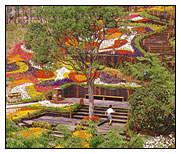 What is landscaping? In simple terms, it encompasses everything in our surrounding environment – mountains, water, trees, forests, parks, bridges, flowers, rocks, and living creatures – all of which are part of landscaping. We are well aware of the socio-economic role of landscaping, such as preventing pollution, producing oxygen, and enhancing the quality of life.
What is landscaping? In simple terms, it encompasses everything in our surrounding environment – mountains, water, trees, forests, parks, bridges, flowers, rocks, and living creatures – all of which are part of landscaping. We are well aware of the socio-economic role of landscaping, such as preventing pollution, producing oxygen, and enhancing the quality of life.
However, more importantly, landscaping always provides joy and pleasure to you and your loved ones, creating precious memories that you will cherish throughout your life. In other words, landscaping is a source of treasure that produces memories to be held dearly while you live.
Landscape Design : a constant learning process
I have taught Urban Park Design and Garden Design courses for about five years at Sungkyunkwan University in Korea. While most classes are typically taught with theoretical foundations and processes, I also emphasized and practiced the idea that good and recognized design is created through observing and feeling a variety of objects and works, then recreating them in a different way. I spent a lot of time practicing and cultivating imagination with my students, and I believe that this combination of practice and imagination is crucial in creating good designs. In retrospect, many of my former students, who are now my juniors, say that these processes and practices were very helpful to them.
Design skills are not something that can be acquired directly through school courses. It requires a dedicated effort to distinguish what should be discarded or taken from past designs and to recreate new designs. The question of whether “form follows function” or “function follows form” was a significant issue in the design field a long time ago, but it doesn’t hold much importance now. In the 21st century, the trend in the design industry is changing at a rapid pace, and landscape works are now recognized as one form of artistic works. Landscape works without such artistic elements are not highly recognized in practical terms.
For a Successful Landscape Design
If you are a landscape architect, you must create a valuable and meaningful work, which requires endless effort that may not be visible until such a design is made. Clearly, any form must have a meaning inherent to that form. In order to effectively convey such meaning and thoughts, you must be able to express and explain it by drawing it yourself. This requires habitual practice of associating and organizing design in our daily lives. Here are five exercises for that practice: 1) art, 2) music, 3) travel, 4) photography, and 5) advertising.
1. ART
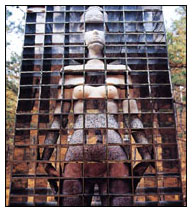 Colors have their own feelings and emotions. Compare the feeling of the colors in the picture to the feeling you usually have about the color. Think about the balance, focus, theme, symmetry, contrast, composition, and layout in the picture and associate them with your design. Observe the shapes and lines of various sculptures and crafts carefully. Also, always think about the depth of the shadows in the picture. In the plane, shadows are the only way to express depth and distance. Observe the picture carefully and think about the theme that the artist wants to show in the picture. And create a story that is hidden in the image by yourself. The shortcut to making a good and recognized design is to create a theme and story in the design.
Colors have their own feelings and emotions. Compare the feeling of the colors in the picture to the feeling you usually have about the color. Think about the balance, focus, theme, symmetry, contrast, composition, and layout in the picture and associate them with your design. Observe the shapes and lines of various sculptures and crafts carefully. Also, always think about the depth of the shadows in the picture. In the plane, shadows are the only way to express depth and distance. Observe the picture carefully and think about the theme that the artist wants to show in the picture. And create a story that is hidden in the image by yourself. The shortcut to making a good and recognized design is to create a theme and story in the design.
2. MUSIC
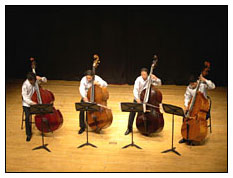 We listen to music in our daily lives every day. Whether we like it or not – on TV, on a computer, or in a car – we can listen to it anytime, anywhere. Among various kinds of music, we still have genres and songs that we like. When you listen to your favorite music or sing or play a song yourself, think about rhythm, stress, tempo, repetition patterns, and harmony. All of these elements are essential to design. In design, all of these elements are organically related to each other. Whether the music is from a grand and majestic orchestra or an elementary school choir, the design elements in the music are the same.
We listen to music in our daily lives every day. Whether we like it or not – on TV, on a computer, or in a car – we can listen to it anytime, anywhere. Among various kinds of music, we still have genres and songs that we like. When you listen to your favorite music or sing or play a song yourself, think about rhythm, stress, tempo, repetition patterns, and harmony. All of these elements are essential to design. In design, all of these elements are organically related to each other. Whether the music is from a grand and majestic orchestra or an elementary school choir, the design elements in the music are the same.
3. JOURNEY
 Most people love to travel. Travel not only gives us a break for our body and mind, but also helps us refresh our spirits and create new ideas. Moreover, it allows us to gain new knowledge, learn and experience new things. It always leads us to take a new path and experience new feelings without fear. The trend of modern design is always changing, and it constantly demands new ideas. What you see, hear and feel through your travels can be naturally applied to your design work. Keep them in your memory and apply them to your design when needed.
Most people love to travel. Travel not only gives us a break for our body and mind, but also helps us refresh our spirits and create new ideas. Moreover, it allows us to gain new knowledge, learn and experience new things. It always leads us to take a new path and experience new feelings without fear. The trend of modern design is always changing, and it constantly demands new ideas. What you see, hear and feel through your travels can be naturally applied to your design work. Keep them in your memory and apply them to your design when needed.
4. PICTURE
 Instead of being the subject of a photograph, I recommend having a hobby of taking pictures by holding the camera yourself. Observe closely when taking pictures. Taking good photos depends on how well you design the subject or space within the frame of the photo. Adjusting the colors of the photo, positioning the subject, matching the composition and frame, combining various elements required for design through photography can create countless photos and different feelings, which will greatly help turn your work into a special and wonderful piece of art.
Instead of being the subject of a photograph, I recommend having a hobby of taking pictures by holding the camera yourself. Observe closely when taking pictures. Taking good photos depends on how well you design the subject or space within the frame of the photo. Adjusting the colors of the photo, positioning the subject, matching the composition and frame, combining various elements required for design through photography can create countless photos and different feelings, which will greatly help turn your work into a special and wonderful piece of art.
5. ADVERTISEMENT
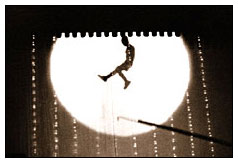 Nowadays, we are living in a flood of information and advertisements. If we take a closer look at how advertising has changed over the past few decades, we can also see how the design of advertising has evolved. The mission of advertising is to “deliver a message.” Its main purpose is to influence and inform the general public. When we look at advertisements nowadays, we see that using paradoxical and exceptional methods can have a greater effect than directly conveying the message. Examine successful advertisements closely. Analyze the themes, methods of message delivery, and design elements that made the advertisement successful. If you become more familiar with a more subtle and sharp way of communicating your message, your design can contain “hidden” messages, elevating your work to the next level.
Nowadays, we are living in a flood of information and advertisements. If we take a closer look at how advertising has changed over the past few decades, we can also see how the design of advertising has evolved. The mission of advertising is to “deliver a message.” Its main purpose is to influence and inform the general public. When we look at advertisements nowadays, we see that using paradoxical and exceptional methods can have a greater effect than directly conveying the message. Examine successful advertisements closely. Analyze the themes, methods of message delivery, and design elements that made the advertisement successful. If you become more familiar with a more subtle and sharp way of communicating your message, your design can contain “hidden” messages, elevating your work to the next level.
Apart from the five elements mentioned above, everyday activities such as watching movies, reading books, playing games, etc. can also be transformed into design exercises based on your thoughts. The important thing is to recognize, record, and apply potential inspiration from your daily life to your designs.
If you are not satisfied with your design, it is natural that everyone else who sees your design will not be satisfied either. Whether the project is big or small, the philosophy that there must be a theme and a story that contains that theme in the design should be embraced in order to make significant progress.
Lastly, I would like to share some things that can help not only students majoring in landscape architecture but also young people in Korea to live in the world ahead.
- Challenge and Courage: For us, especially for young people, this world is full of endless things. However, goals that can be easily achieved are just too small in our lives. Most people easily give up and forget about things they think are too difficult. But those who have courage and challenge eventually succeed. This is because having a clear goal gives momentum, and there are not many competitors on the way. Easy tasks have intense competition because everyone can try them. However, difficult tasks that require courage and risk-taking have fewer competitors. Start now. The path to success through trial and error will appear automatically.
- Experience: Even without quoting the Korean proverb, “you still suffer when you’re young,” the abundant experiences we have when we’re young are emphasized no matter how much we talk about them. Especially when the experience is challenging and difficult for ourselves. Experiencing something once is much more useful than reading or hearing about it 100 times. Experience cultivates the power to cope with various changes and prepares many alternatives to solve problems. “Diverse experiences” will be a great asset to your future.
- Love: When asked many successful people about their lives, they always say that “making others happy” was always the basis. When the same passion was applied to their jobs and businesses, they succeeded. It is important to accumulate numerous experiences and have the courage to challenge ourselves. However, if love is not in that person’s heart, then all of those efforts cannot last long. Love everything around you and everyone around you. If you can’t, practice it consciously and consistently. The beginning of everything you want to achieve is “love”.

